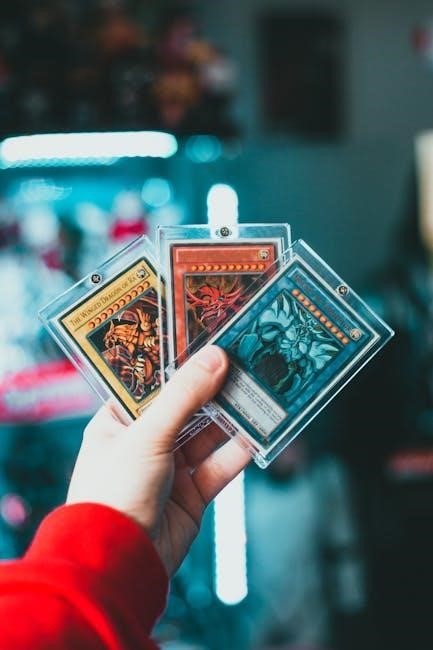Discover how a simple deck of cards can transform math learning into an engaging, interactive experience. Fun games make practicing arithmetic, algebra, and more enjoyable for all ages.
Benefits of Using Playing Cards for Math Education
Using playing cards in math education offers numerous benefits. They provide an interactive and hands-on way to practice arithmetic, making learning engaging and fun. Games like Addition Quick Draw and Multiplication Quick Draw help improve number recognition, addition, and multiplication facts. These activities also enhance problem-solving skills and strategic thinking. Playing cards are portable and easy to use, allowing students to practice math anywhere. They cater to different learning styles, making math accessible and less intimidating. Incorporating card games into math education fosters collaboration and healthy competition among students, while also reinforcing key concepts in a dynamic way. This approach makes math enjoyable and memorable for learners of all ages.

Arithmetic and Number Skills
Playing cards enhance arithmetic skills through games like Addition Quick Draw and Multiplication Quick Draw, improving number recognition, addition, and multiplication facts in an engaging way.
Addition Quick Draw: Practicing Addition Facts
Addition Quick Draw is a fast-paced game that helps students master addition facts. Players take turns flipping two cards from a shuffled deck, adding the numbers together. The goal is to reach a target sum, such as 27, or simply to practice quick mental math. Face cards are typically removed, and Aces can be valued as 1 or 11, depending on the teacher’s preference. This game encourages speed, accuracy, and healthy competition, making it an effective tool for building arithmetic fluency. It’s ideal for small groups or pairs and can be adapted to different skill levels by adjusting the target sum or the number of cards drawn.
Multiplication Quick Draw: Practicing Multiplication Facts
Multiplication Quick Draw is an exciting game designed to sharpen multiplication skills. Players use a standard deck of cards, removing face cards, with Aces valued as 1 or 11. Each player flips two cards, multiplies the numbers, and the highest product wins. This fast-paced game fosters quick thinking and accurate calculations, making it ideal for practicing multiplication facts. It’s perfect for pairs and can be tailored to different skill levels by adjusting the target product. The competitive nature of the game keeps students engaged while building their multiplication fluency in a fun and interactive way.
Break the Bank at 27: Addition Practice
“Break the Bank at 27” is a dynamic addition game that challenges players to reach a total of 27 without exceeding it. Using a deck of cards with face cards removed, players take turns drawing cards and adding their values. Aces are typically worth 1, while numbered cards retain their face value. The game begins with each player receiving five cards, and the remaining cards are placed face down in a draw pile. Players aim to combine their cards to get as close to 27 as possible. This game enhances mental math skills, strategic thinking, and understanding of addition concepts. It’s an engaging way to practice addition facts while competing to “break the bank”!
Ten or Twenty: Addition Games
“Ten or Twenty” is a fun and competitive addition game designed for 2-4 players. Using a deck of cards with face cards removed, players aim to create an addition problem with three addends that totals either 10 or 20. Aces are worth 1, Jacks are 11, Queens are 12, and Kings are 13. Each game consists of five rounds, and points are awarded based on how close players are to the target totals. This game sharpens mental math skills, encourages strategic thinking, and reinforces addition concepts. Players must balance risk and precision to accumulate the most points, making it an exciting way to practice addition while aiming for the perfect total of 10 or 20.
Close to 20: Addition with Three Addends
“Close to 20” is an engaging addition game where players aim to create sums as close to 20 as possible using three addends. Aces are worth 1, face cards are removed, and Queens are treated as 0. Players draw three cards, add their values, and record their total. The goal is to get as close to 20 as possible without exceeding it. This game is ideal for younger students, as it introduces the concept of three-addend addition in a fun, competitive way. The player with the total closest to 20 at the end of five rounds wins. “Close to 20” not only improves addition skills but also encourages strategic thinking and mental math practice.
Algebra and Equations
Playing cards can be used to create and solve algebraic equations, making abstract concepts more tangible. Cards represent variables and coefficients, allowing students to visualize and manipulate equations effectively;
Creating Equations from Card Combinations
Using a deck of cards, students can create algebraic equations by assigning numerical values to each card. For example, Aces can be 1, numbered cards represent their face value, and face cards (Jack, Queen, King) can be assigned 11, 12, and 13, respectively. Players draw a set of cards and use their values to form equations. This activity helps students understand how variables and constants work together in equations. Teachers can adjust the complexity by adding or removing cards to suit different skill levels. This hands-on approach makes abstract algebraic concepts more tangible and engaging for learners of all ages.
Solving Equations Using Card Values
Students can solve algebraic equations by using card values to represent variables and constants. For example, if a player draws a 3 and a 5, they can solve an equation like (3x + 2 = 10) by substituting (x = 2) (since (3 imes 2 + 2 = 8), which is close to 10). This game helps learners understand inverse operations and balancing equations. Teachers can create equations with unknowns and have students draw cards to find solutions. Advanced players can use negative numbers or multi-digit card values for added complexity. This interactive method makes solving equations a fun, hands-on experience, reinforcing algebraic reasoning and problem-solving skills. It also encourages critical thinking and mathematical fluency in a collaborative setting.

Geometry and Measurement
Explore geometry and measurement with card-based activities that teach shapes, spatial reasoning, and length calculations. Build structures and measure distances, making math hands-on and intuitive for learners of all ages.
Euclid’s Geometry: Shapes and Theorems
Euclid’s Geometry transforms traditional geometry lessons into interactive card games. Players use cards to create and identify shapes, explore theorems, and apply basic geometric principles. The game involves drawing cards with specific point values, which are used to construct polygons or calculate distances. This hands-on approach helps students visualize concepts like triangles, circles, and lines. By aligning card values with Euclid’s axioms, the game fosters a deep understanding of foundational geometry. It also encourages problem-solving and spatial reasoning, making complex ideas accessible and fun. This innovative method bridges theory with practical application, ensuring students grasp geometry in a memorable way.
Measuring and Building with Cards
Measuring and Building with Cards introduces students to measurement and construction concepts using a deck of cards. Players create structures by balancing and arranging cards, learning about length, width, and height. This game enhances spatial awareness and fine motor skills while teaching units of measurement. By assigning specific values to cards (e.g., 1 unit per card), students can practice measuring distances and calculating totals. The activity also encourages creativity and problem-solving, as participants must stabilize their creations. This interactive approach makes geometry and measurement engaging and accessible, allowing students to visualize mathematical principles in a hands-on way while fostering teamwork and critical thinking.

Probability and Statistics
Card games introduce probability and statistics through interactive activities. Players predict outcomes, calculate odds, and analyze data, fostering a deeper understanding of chance and statistical reasoning.
Understanding Probability with Card Games
Card games offer an engaging way to teach probability and statistics. Players can explore likelihoods by predicting card outcomes, calculating odds, and analyzing data. For example, drawing specific card values or suits helps students understand chance and probability distributions. Simple games like predicting whether the next card will be higher or lower than the current one introduce basic probability concepts. More complex activities involve calculating the probability of drawing certain combinations, such as pairs or sequences. These exercises make abstract concepts tangible, fostering a deeper grasp of probability and statistical reasoning through hands-on practice.
Each round provides immediate feedback, allowing learners to refine their understanding and make data-driven decisions. This interactive approach makes probability fun and accessible for all skill levels.

Advanced Math Concepts
Card games introduce complex math like calculus and number theory. They model scenarios for understanding rates of change, probabilistic models, and advanced number patterns, making learning interactive and enjoyable.
Slope and Rate of Change: Math in Motion
Explore advanced math concepts using card games that visualize slope and rate of change. Players build a spiral game board with a deck of cards, placing game pieces at specific card positions. Each card represents a point on a graph, allowing students to calculate slope by determining the change in y over the change in x between two points. This interactive approach makes abstract concepts tangible. By drawing cards to represent changes in values, students practice calculating rates of change and understanding motion in a hands-on way. This game aligns with real-world applications, such as analyzing speed or growth rates, making complex math engaging and accessible for learners of all levels.
Math Delve: Exploring Chemical Reactions
Combine math and chemistry with a card game that delves into chemical reactions. Students use a deck of cards to represent elements and compounds, assigning numerical values to each card. The game involves calculating molecular weights, balancing equations, and understanding stoichiometry. For example, players draw cards to form chemical compounds and compute their molar masses. This interactive approach helps students visualize how elements combine and react. The game also incorporates probability and statistics to predict reaction outcomes. By linking math to real-world chemistry, Math Delve fosters a deeper understanding of both subjects in a fun and engaging way. It’s perfect for students interested in STEM fields.
Playing cards are a versatile, engaging tool for math learning, fostering creativity and critical thinking while making complex concepts fun and accessible for learners of all ages.
Why Playing Cards Are a Great Tool for Math Learning
Playing cards offer a versatile and engaging way to teach math concepts, from basic arithmetic to advanced algebra. They provide hands-on learning, fostering problem-solving skills and strategic thinking. Games like Addition Quick Draw and Multiplication Quick Draw make practicing math facts fun and interactive. Cards also introduce probability and geometry through shape-based games. Their portability and simplicity make them ideal for classroom or home use. By turning math into a game, playing cards motivate learners, encourage healthy competition, and create a positive association with math. This tactile approach helps students visualize concepts, making complex ideas more accessible and enjoyable for all ages.
